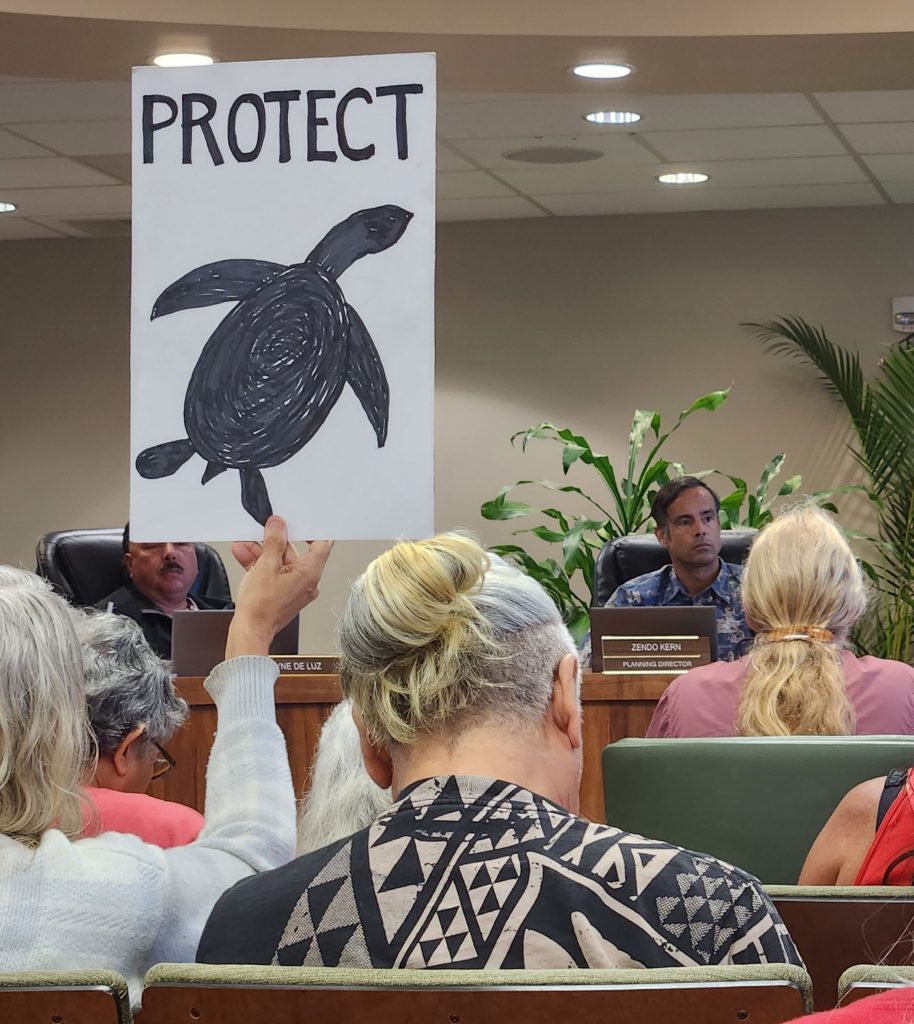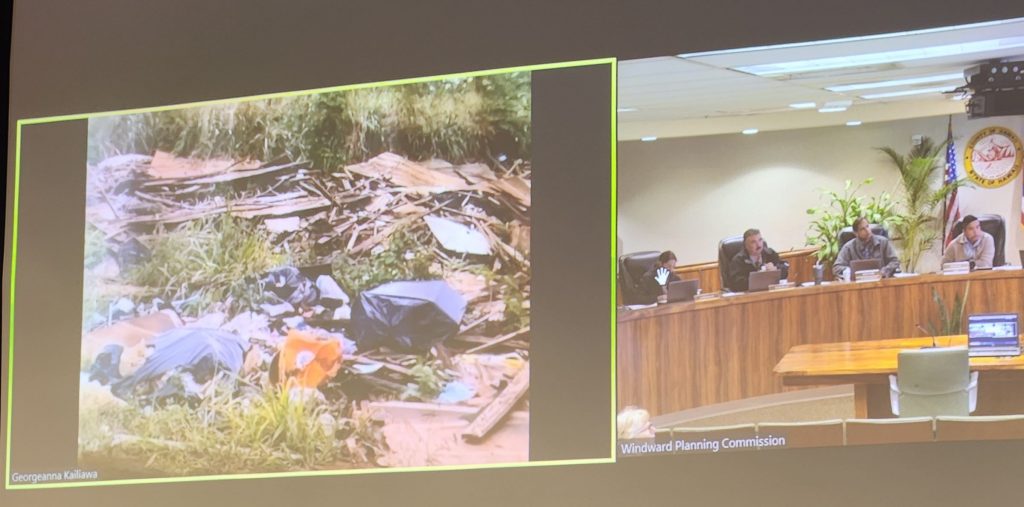Standing granted for 2 of 3 petitions in contested case about controversial proposed Punalu‘u development special use permit
The developer of a controversial proposed Ka‘ū residential and commercial community on the Big Island will have to wait to find out if it will be approved for a special management area use permit to move forward with project — or if it will be considered at all — following a special meeting Monday of the Hawai‘i County Windward Planning Commission in Hilo.

Commissioners granted standing for petitions in a contested case hearing filed by the Center for Biological Diversity and ‘Iewe Hanau o Ka ‘Āina. Both organizations object to the special use permit sought by Black Sand Beach LLC to develop Punalu‘u Village on 147 acres around Punalu‘u Black Sand Beach Park, about 6 miles southwest of Pāhala.
The park and property, which is located in the former Sea Mountain at Punalu‘u resort area, are east of Hawai‘i Belt Road (Highway 11) off Nīnole Loop Road.
Standing was denied for a third petition from the Association of Apartment Owners of Colony 1 at Sea Mountain. The condo and resort facility is located within 300 feet of the proposed development.
Because standing was granted for two of the three petitions, commissioners deferred making a decision on the special use permit. They also consolidated the approved petitions into one hearing with no objection from representatives of the petitioners and developer.
The proposed development, which could cost up to $350 million, has run up against a wall of opposition from Ka‘ū community members, residents from elsewhere throughout Hawai‘i and even people from the mainland who say it not only threatens the environment, it would desecrate cultural sites.
There also are concerns about the cost of living increasing because of the development, outside influence in the community, destruction of the pristine Punalu‘u coastline, threat of wildfire because of the state of the former resort buildings, larger numbers of people in the area and loss of a way of life along with historical and generational knowledge, among others.
The Center for Biological Diversity has a legally protected interest in the survival and recovery of endangered and threatened species and their habitats.
Members, some of whom are descendants of Native Hawaiians who inhabited the Hawaiian Islands prior to 1778, have a vested interest in the species, habitat and natural and cultural environment at Punalu‘u, which would be impacted by the proposed development.
Maxx Phillips, Hawai‘i program director and staff attorney for the center, said after Monday’s meeting that the commission made the right decision to grant her organization standing in the contested case hearing.
“Not only for the endangered and threatened species of Punalu‘u, but for our lāhui [people] of Punalu‘u, whose traditional and customary practices need to be protected at all costs,” said Phillips.

She said a development the size of the proposed Punalu‘u Village — which would include 225 residential and short-stay units, a village and wellness center, rehabilitation of an existing golf course and tennis facilities, as well as extensive infrastructure — needs an updated and valid environmental impact statement, especially when an upgraded wastewater system is also necessary.
“There’s no way that this commission, let alone the community, will know the true impacts of a development like this without having all the facts in front of them,” Phillips said. “A developer can’t rely on outdated data. The developer cannot rely on using Hawaiian words and brownwashing and greenwashing a development of this magnitude for rural Ka‘ū. The developer needs to actually show what the true impacts will be, which are going to be huge.”
David Frankel, an independent O‘ahu attorney who represents environmental and Hawaiian groups trying to protect natural and cultural resources, is representing ‘Iewe Hanau o Ka ‘Āina and said they were happy with the commission’s decision on the organization’s petition.
“You know, it should have been a no-brainer,” said Frankel.
‘Iewe Hanau o Ka ‘Āina’s concerns also include a need for a new environmental impact statement so the community can have all the information upfront and know the possible impacts.
Another issue is with the historic preservation review process of the proposed development, which Frankel said requires an archaeological inventory survey to be completed before a decision can be made on the special use permit.
“A survey like that would document where all the burials are,” he said. “It’s very important to my client that burials be protected. That’s a significant issue.”
Water quality is a concern, particularly because of the neglected sewage treatment plant on the former resort property. The existing wastewater system also does not have the capacity to handle the influx of people the proposed development would bring to the area.
The spike in how many people are in Punalu‘u and water quality issues also will impact the animal and plant life there. ‘Iewe Hanau o Ka ‘Āina, which also has members descended from Native Hawaiians who inhabited the islands before 1778, is concerned about the endangered and threatened species of the area.
That includes the threatened nēnē (Hawaiian goose) that hang out on the golf course, endangered green sea turtles and critically endangered hawksbill turtles that nest at Punalu‘u.
Furthermore, Frankel said more people means less access to the area to local residents and detracts from and changes the experience of those who live and visit there.
The developer’s representative Lincoln Ashida, an attorney and director with Honolulu-based law corporation Torkildson Katz, former Hawai‘i County corporation counsel and former Hawai’i County prosecuting attorney, wasn’t surprised by the commission’s decision.
“I always respect the commission’s decision,” said Ashida, who represented the county’s commission when he was corporation counsel. “I know they’re volunteers, and I know that they all want to do the right thing.”
Commissioners granting standing to the Center for Biological Diversity and ‘Iewe Hanau o Ka ‘Āina is a good thing, Ashida said, so both sides can fully lay out their cases. He and his client look forward to having the case heard on its merits.
From what he saw, commissioners thought hard about the petitions and examined the issues.

The first thing he noticed when he became involved in the case was that there was such a divide between what people opposed to the proposed development were saying and the project’s reality.
“I don’t blame them at all, not one bit, that they would be suspicious, that their immediate intuitive thing is, wait, hold on, no, not here,” Ashida said, adding many places on the Big Island have faced similar issues and conversations. “That’s why I think the contested case actually may be a blessing because I think we’re really going to be able to develop and see some of the community benefits in this.”
When he was presented with the opportunity to represent Black Sand Beach LLC in the contested case, he could see what the proposed development could do for the community.
“Like all things, it takes time for things, for the truth, to come out sometimes,” Ashida said. “I think at the end of the day, when people see it, I’m hopeful that they’ll see the benefits, that how Ka‘ū can really benefit and then our island benefits.”
There is a mandatory 30-day mediation period before the contested case hearing can start. Barring any unusual delays, Phillips and Frankel agreed a decision in the contested case hearing could come within a year.
Ashida didn’t estimate how long it could take for a decision to be made.
How long the hearing process will ultimately last depends on who is selected to hear the case as different hearing officers have varying styles. The commission decided to hire a hearing officer instead of itself or some of its members handling proceedings.
“However long it takes, it’ll take, and it’s OK,” Ashida said. “As long as both sides are respectful to one another.”

Jeff Silva, vice president of the Association of Apartment Owners of Colony 1 at Sea Mountain and a condo owner at the facility, thinks the commission’s decision to deny his association’s petition was wrong.
Commission Chairman Dennis Lin and member Wayne De Luz questioned who had the authority to represent the association and if the petition was supported by all of its 76 members.
Lin pointed out that it was the facility’s property manager who signed the petition, not a representative of the association’s board, and wanted to make sure none of the owners were being misrepresented.
Silva told commissioners that the association is not taking a position on the proposed development itself since members’ opinions vary. What they agree on, the reason the board filed its petition, is that the property’s neglected water system needs to be addressed.
Deficiencies in the water system directly impact the health and safety of all of the association’s owners through the drinking water, sewage and wastewater and even fire suppression systems.
The association has tried to get Black Sand Beach LLC and Eva Liu, who owns the property where the development is proposed and the water system it contains, to move on the issue for the past 4 years, but nothing has been done.
Silva assured the commission that the board had given him authority to represent it and authorized the property manager to submit the petition. Documentation is available. However, it was not a part of the petition.
“It was a technicality that I think wasn’t correct because the application did not specify that they needed those documents and our property manager has the full authority of the board,” he said.
Silva thinks the association would have been granted standing had all members of the commission would have been present during Monday’s meeting.
Commissioners voted 3-2, with Lin and De Luz voting no. Four affirmative votes were needed for standing to be granted for each of the petitions. Commission member Matthias Kusch was not present, leaving just 5 members to vote.
The association can appeal the commission’s decision. Silva said a special board meeting could be scheduled in the next few days to discuss its next move.
He said the issues with all three parts of the water system have been ignored by “the powers that be.” The Hawai‘i Public Utilities Commission hasn’t responded to board letters. The Hawai‘i Department of Health also isn’t responding to the association board.
“So, we’re seeking remedy through the legal county process, and once again, they took that opportunity away from us rather than going toward openness,” Silva said.
The commission’s decisions followed about 5 hours of additional public testimony, the majority of which was again opposed to the Punalu‘u Village development plans.
Monday’s special meeting was the continuation of a meeting March 7, when the commission heard more than 8 hours of public testimony about the proposed development before adjourning for the day without being able to take up consideration of the special use permit issue or the three contested case hearing standing petitions.














